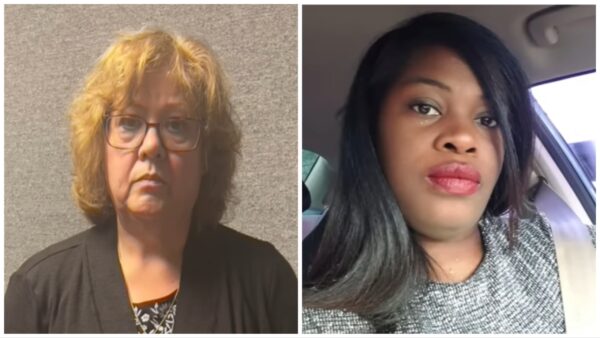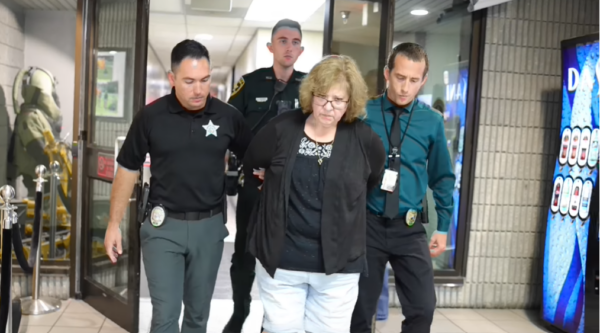A white woman who fatally shot her Black neighbor in Ocala, Florida, has been arrested and charged in connection with the shooting death that’s garnered national attention.
Susan Lorincz, 58, faces multiple charges for shooting 35-year-old Ajike “AJ” Owens including a first-degree felony charge of manslaughter with a firearm as well as culpable negligence, battery, and two counts of assault. A conviction for manslaughter alone would put Lorincz behind bars for up to 30 years.

The Marion County Sheriff’s Office released updated information related to their ongoing investigation into the deadly shooting.
After gathering more evidence, witness statements, and interviews with Owens’ children, detectives discovered that, over a period of time, Lorincz had become angry at Owens’ children who played in a field close to her apartment.
On June 2, after she began arguing with the kids, and threw a roller skate at Owens’ 10-year-old son, hitting him in the toe. The child and his 12-year-old brother went to speak to Lorincz. Lorincz opened the door and swung at them with an umbrella.
That’s when the kids went to tell their mother who then went to Lorincz’s home, knocked on the door multiple times, and demanded Lorincz answer. Lorincz fired one shot through the door, striking Owens in her upper chest. Owens’ 10-year-old son was standing right beside her when this happened.
Investigators who first responded to the shooting scene questioned Lorincz who claimed that she was acting in self-defense and that Owens had been trying to break down her door. She also said that Owens had physically attacked her in the past.

Marion County Sheriff Billy Woods said that the shooting was the result of a two-and-a-half-year-long neighborhood feud between Lorincz and Owens. Deputies had been called to the area over that time at least a half-dozen times since January 2021. Lorincz would call to complain about Owens’ children.
Right after the shooting took place, investigators had only questioned Lorincz and gotten her side of the story. During the days that followed, they interviewed witnesses as well as Owens’ children who were questioned by forensic interviewers specialized in interrogating children. After detectives interviewed Lorincz again, they arrested her.
Alongside these interviews, detectives gathered and reviewed forensic evidence, digital evidence, and surveillance footage obtained from various sources. They also reviewed details of prior incidents and calls for service involving Lorincz and Owens.
As a result of those interviews and the compilation of evidence, detectives were able to establish that Lorincz’s actions were not justifiable under Florida law.
What’s come into question in the days since the shooting is Florida’s infamous “stand your ground” law, which Marion County Sheriff Billy Woods previously noted was a factor for why deputies did not immediately arrest Lorincz until they proved that she did not act in self-defense. Later on, upon further investigation and after Lorincz’s arrest, Woods said that the law did not apply to this case.
“Personally, I think it’s a great law designed to help Floridians to defend themselves and keep themselves safe. However, it does not apply in all situations. And this situation is a prime example of when it was not justified. It was simply a killing.”
Owens’ family, who is being represented by civil rights lawyer Ben Crump, has been calling for an arrest since the shooting happened.
Crump also represented Trayvon Martin’s family back in 2012 in the case that drew worldwide attention over the stand-your-ground law and helped bring the Black Lives Matter Movement to life after the teen was shot and killed by George Zimmerman.
Crump released an account of the events that led up to the shooting, including that Lorincz yelled racial slurs at the children when she first argued with them. Police have yet to confirm those specific details and if racial harassment played a role in the incident. Owens’ mother, Pamela Dias, said Lorincz called the kids “slaves” and used the “n-word” when referring to the children. One of Owens’ neighbors also stated that Lorincz called the children names.
In a similar case back in April, 84-year-old Andrew Lester, a white man, shot and injured 16-year-old Ralph Yarl, a Black teenager who rang his doorbell in Kansas City, Missouri after Yarl mistakenly showed up at the wrong house to pick up his younger twin brothers. Instead of answering, Lester shot Yarl through the door. Lester was also arrested and now faces two felonies.
Missouri and Florida are just two of nearly 30 states that have enacted stand-your-ground laws. This law has been the center of debate over several shootings.
In 2017, Florida lawmakers updated the state’s statute to shift the burden of proof in defendants’ claims of stand-your-ground immunity from the accused to prosecutors. That means prosecutors must prove to a judge that the stand-your-ground defense is not valid, rather than a defendant proving it is. So if someone shoots and kills another person and claims he had no duty to retreat as he acted in self-defense and therefore should be immune from prosecution — a stand-your-ground claim — the shooter isn’t obligated to prove this case in front of a judge at an immunity hearing. That’s the prosecutor’s job.
Opponents of the law claim that the shifting burden makes it more difficult to convict those who commit violent crimes and claim self-defense. Before this change, prosecutors could just charge someone with a shooting, and then defense attorneys would have to present a case for why their client shouldn’t be convicted.
Before Lorincz’s arrest, Sheriff Woods said detectives had contacted the State Attorney’s Office to investigate Lorincz’s self-defense claims before they could move forward with any possible criminal charges.
According to 2022 Census reports, the city of Ocala, Florida, is predominantly populated by white citizens. More than 68 percent of the town is white while only approximately 20 percent of the town is Black. In Marion County, where Ocala is located, more than 80 percent of the county is white, and less than 14 percent is Black.


